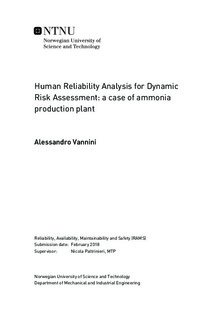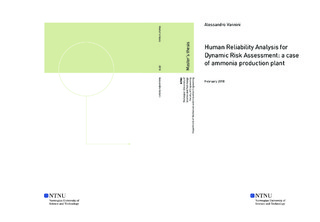| dc.description.abstract | Human and organizational factors play a key role for the prevention and mitigation of major
accidents. Risk assessment techniques, as the classical Quantitative Risk Analysis (QRA), are
only focused on the analysis of technical factors. Integration with Human Reliability Analysis methodologies can cope this problem, but their application is still limited to the nuclear and, more recently, to the petroleum sector. Moreover, the inability of the QRA to represent the evolution of system conditions affecting risk is another limitation that built up the basis for the Dynamic Risk Assessment. The present work shows how these models can be applied also for the chemical process industry, emphasizing the influence on risk of the human and organizational factors and how they can be accounted into the risk assessment. As a representative sector of the chemical process industry, the ammonia production plant is considered. To better understand the nature of incidents and the main problems related to the ammonia plant, a description of the process with a discussion about the most common problems in the apparatuses involved is performed. A creation of a database about past incident, accident and near misses occurred in the ammonia plant accounting nine different sources was created. The analysis of the database showed that the most frequent general cause of incident is a mechanical failure (over 60%). Nevertheless, the work will focus on the human factors, representing the second cause of incidents (38%). While assessment of technical failures is consolidated, human aspects may be relatively disregarded and represent a critical aspect. A catastrophic rupture occurred in Lithuania in 1989 is taken as a representative case study to demonstrate how human and organizational factors can be considered into the risk assessment. A preliminary bow tie diagram to identify causes of the rupture and safety barriers is performed. Then, an overview of different methods for the analysis of human and organizational factors is performed. In particular, the three following methods were applied to a representative real case study. The Resilience-based Early Warning Indicator (REWI) methods, establishing a set of indicators, whose periodic monitoring can contribute to manage risk in a proactive way. It addresses organizational aspects related to the entire installation and to all its risks. The Petro-HRA method. which is a novel technique for the Human Reliability Analysis suited for the petroleum industry. It provides a systematic way to assess human and organizational factors through a detailed step procedure. In this way, factors and systems that can be improved to reduce the HEP and the overall system are pointed out. Moreover, the quantification of the Human Error Probability of a specific operation allows the application of this method within a QRA framework, giving a more detailed overall risk assessment. Eventually, the TECnical Operational and organizational factors (TEC2O) method for Dynamic Risk Assessment is also evaluated. It allows risk variation to be accounted through the frequency modification factor (t) which updates the frequency of a selected dangerous phenomenon during the lifetime of the plant. It takes into account technical, human and organizational factors, combining the strength of the HRA methods to the dynamic and resilience characteristic of the REWI methodology. The result show a more complete and realistic risk assessment and allow identifying weak and strong points of each method. | en |

